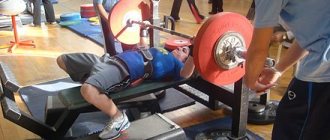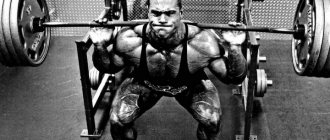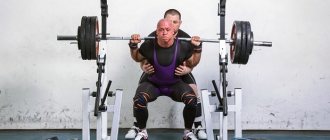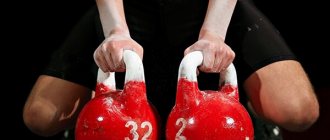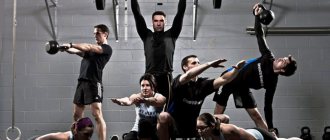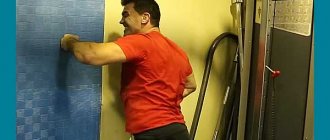Choosing tights for powerlifting - tips ( 1 votes, average: 5.00 out of 5)
No powerlifting activity can be imagined without powerlifting tights . All athletes know this! Why do you need tights and what role does it play when playing this sport? What is its purpose?
Adidas Powerlifting Tights: Injury Tips
In weightlifting, the main thing is to have support for your knees, back and ankles. This will be more than enough to avoid injury.
But there are many other places in this sport that are not immune to injury. Since the legs stand much wider when squats, there is a risk of falling or going down, which can injure the groin area. In this case, you may injure the ligaments.
Good tights for great athletes
Powerlifting - what is it, its differences
Powerlifting or powerlifting is a sport. Athletes competing in powerlifting competitions set their main goal to overcome the resistance of the maximum weight for the athlete. Raising maximum weights occurs in three exercises; the competitive results of weightlifters of the same weight category are compared with each other and assessed in total based on the weights taken in all 3 exercises.
Bodybuilding is aimed primarily at developing muscle mass, relief and body proportions, and does not require high functionality, while powerlifting is focused on constantly increasing strength results.
Powerlifters do not need to develop endurance, unlike track and field athletes, as well as athletes competing in the CrossFit discipline.
Cloth
Powerlifting clothing
Wrestling tights for powerlifting
Wrestling tights are an essential attribute of any powerlifter.
Be sure to purchase it if you intend to perform in the future. It is also good for training.
Powerlifting T-shirt
An important rule of the competition is to have a short-sleeve T-shirt of the same color. The T-shirt should not cover the athlete’s elbow joint, so that there are no questions from the referee.
Powerlifting Gaiters
Gaiters are a must-have piece of equipment when performing deadlifts.
In this exercise, the bar comes into contact with your shin and can tear skin, so gaiters are used for safety and sterility. When competing in powerlifting, you must have tights, a short-sleeve T-shirt and leg warmers.
https://youtu.be/y1fWYZVweDI
Basic Training Principles for Strength Development
Powerlifting training is exclusively strength-based. Which means a periodic but regular increase in the intensity of training and an increase in the volume of the total load produced in the form of weights lifted by the athlete.
In practice, the training regimen looks like this: Powerlifters work on one or two multi-joint competition movements each workout, in 4-6 sets, with a low number of repetitions (2-5 repetitions).
This is another difference from bodybuilding, in which athletes most often work out only one or two muscle groups in one workout, performing 3-4 working approaches for an average number of repetitions (8-15).
Creating a powerlifting training program
Training programs for powerlifting should be compiled by experienced athletes who understand the specifics of approaches to strength training, and also understand the need for an individual approach to the selection of a training program, depending on his personal strength qualities, experience, as well as the anatomy and physiology of the athlete.
Every novice athlete who decides to engage in power lifting is recommended to first master the basics of the correct technique for performing the classic three basic exercises; it would not be a bad idea to visit any good powerlifting section/school. Work with a personal mentor at the initial stage of training, who will explain the main principles of powerlifting and help you begin targeted, effective training as quickly as possible.
The “golden three” of powerlifting are the squat, bench press and deadlift. These are classic basic exercises. Without their implementation, it is impossible to achieve significant development of strength and impressive muscle volumes.
In addition, a powerlifter's program should have a place for auxiliary exercises designed to work on weak points when performing exercises that limit overall performance. Such movements include hyperextension, wide-grip pull-ups, leg press in a machine, bending over with a barbell, as well as dips, etc.
A powerlifter needs more rest time between sets than a bodybuilder. If in bodybuilding it averages 1-2 minutes, then in powerlifting, due to the specifics of the heavy load, you will need up to 5 minutes of rest or more before performing the next approach.
Number of workouts per week: since heavy loads require quite a lot of time for muscle recovery, it is recommended to stop at 3 (maximum 4) visits to the gym per week.
Periodization of loads in powerlifting
Training in powerlifting involves a regular progression of loads, but it will not be possible to constantly linearly increase the weights on the bar from session to session, because such a technique will certainly cause the athlete a phenomenon called overtraining syndrome and can lead to a loss of desire to train at all. To prevent this, it is necessary to use the principle of load periodization.
The principle comes down to alternating loads, namely, heavy exercises are replaced by fairly light ones, and then light ones are replaced by workouts with a medium load.
This periodization of loads can be applied both within one week and over the course of a month, i.e. microcycles and mesocycles are used.
In practice it looks like this:
- first week (heavy) – the athlete performs a bench press with a weight of 100 kg in 5 sets of 5 repetitions,
- second week (easy) – 60 kg bench press in 3 sets of 8 repetitions,
- third week (medium) – 80 kg bench press in 4 sets of 6 repetitions,
As already noted, the training program used in powerlifting is tailored to each athlete individually. An experienced trainer leaves it based on your personal characteristics, experience and the results of the “pass” (read about it below).
It is most common to create such programs for a 3-month period, since their preparation for longer periods will lead to the body becoming accustomed to the load and slowing down the rate of your progress. Therefore, after training for three months, it is necessary to re-do the drilling and make changes to the training plan.
Most strength training programs in powerlifting are designed for 3 workouts per week. In the program, there is always a bench workout between the squat day and the deadlift day. Since the legs are heavily involved in both squats and deadlifts, they should be given more time to recover, so a bench press is always placed between the squat and deadlift. Sometimes, on one training day, 2 basic exercises are performed, but in this case, one of them is performed with large weights, and the other with small ones.
Walking in powerlifting
“Passing” in powerlifting is the definition of the maximum weight in each of the three competitive lifts that an athlete can lift. Competently drawing up a training program requires mandatory drilling. A feature of training programs in powerlifting is the use of a percentage of one repetition maximum (1 RM) that the athlete lifts.
Based on this principle, 3 types of training are distinguished: light, medium and heavy, in which work is performed with various weights of weights (in light training, the load is 50% of 1 rep.M., in medium - 65%, and in heavy - 90% ).
It is possible to perform powerlifting exercises on all muscle groups in one day, but it is necessary to take a long break between approaches. For example, first perform a squat, then a barbell press, and finally a deadlift, but a prerequisite for progress is a thorough warm-up and warming up of the muscles before each super-heavy approach.
It is necessary to carry out penetration by gradually increasing the weight on the bar between approaches, initially it increases by 10 - 20 kg, in the last approaches up to 2-3 kg.
The walk involves doing it with a partner. Since the goal is to find the maximum weight, the last set should be accompanied by muscle failure and the inability to lift the weight on your own. At this moment you will need a partner, otherwise you will simply be crushed during the bench press or squat.
Examples of Powerlifting Training Programs
Examples of training programs based on the principle of periodization on a weekly cycle, with three workouts per week:
Training program 1
First day:
| Exercise | Approaches | Repetitions |
| 1. Bench press (80% of 1 R.M.) | 5 | 5 |
| 2. Squats with a barbell on the shoulders (60% of 1 R.M.) | 5 | 5 |
| 3. French bench press with a horizontal barbell. bench | 3-4 | 8 |
Second day:
| Exercise | Approaches | Repetitions |
| 1. Deadlift (80% of 1 rep.m.) | 5 | 5 |
| 2. Hyperextension | 3-4 | 10-12 |
| 3. Standing biceps curl | 3-4 | 8-10 |
The third day:
| Exercise | Approaches | Repetitions |
| 1. Bench press (60% of 1 R.M.) | 5 | 5 |
| 2. Squats with a barbell on the shoulders (80% of 1 R.M.) | 3-4 | 10-12 |
| 3. Swing dumbbells to the sides (or bending over/in front of you) | 3-4 | 10 |
As can be seen from the given lesson plans, the working weights depend on the results of driving with maximum weights. This is only a general method of execution; a specific cycle is compiled with the help of an experienced trainer, especially in relation to novice athletes.
Training program 2
Day 1 (pectoral muscles):
| Exercise | Approaches | Repetitions |
| 1. Squats with a barbell on the shoulders (60% of 1 R.M.) | 5 | 5 |
| 1. Bench press (75% of 1 R.M.) | 5 | 5 |
| 3. Standing barbell press (military press) | 5 | 8-10 |
Day 2 (back):
| Exercise | Approaches | Repetitions |
| 1. Deadlift (75% of 1 rep.m.) | 5 | 5 |
| 2. Shrugs with a barbell | 5 | 16-20 |
| 3. Close grip barbell press | 5 | 8-10 |
Day 3 (quadriceps and calves):
| Exercise | Approaches | Repetitions |
| 1. Squats with a barbell on the shoulders (75% of 1 R.M.) | 5 | 5 |
| 2. Calf raises | 3 | 18-20 |
| 3. Barbell row to the chin | 4 | 8-10 |
The duration of this training program should not be longer than 3 months. Training takes place three times a week, with the first week the load being 75% of your repeated maximum, which was determined using walking. The second 7 days the work is performed at 80%, and then the load increases by 2.5% with each subsequent week. As already mentioned, after completing the 3-month cycle, this program must be changed by performing the penetration again.
Training program 3
Day 1:
| Exercise | Approaches | Repetitions |
| 1. Squats with a barbell on the shoulders (75-85% of 1 R.M.) | 5 | 5 |
| 2. Bench press (65-75% of 1 R.M.) | 5 | 16-20 |
Day 2:
| Exercise | Approaches | Repetitions |
| 1. Deadlift (75-80% of 1 rep.m.) | 3-4 | 5 |
| 2. Bent-over barbell row | 3 | 6-8 |
Day 3:
| Exercise | Approaches | Repetitions |
| 1. Squats with a barbell on the shoulders (55-65% of 1 R.M.) | 5 | 5 |
| 2. Bench press (75-85% of 1 R.M.) | 5 | 5 |
| 3. Close grip barbell press | 3-4 | 8-10 |
Classes also take place three times a week. This training program is well suited for beginners in powerlifting. If after performing heavy basic movements there is still strength left, then after them you can add one or two isolating ones to work individual muscles, but you can completely do without using them.
Competition equipment bench press technique
- Lie down on the bench. Grab the bar firmly with a grip of 81 cm between your index fingers. Bend your back as much as possible and bridge, your legs should press firmly into the floor. The body weight is distributed between the shoulder blades and feet, the butt slightly touches the bench, for appearance (DO NOT LYE ON IT, work with your legs).
- Nod your head to the person taking you out or say “Oops.” Slowly accept the barbell with straight arms as you exhale (triceps tense, shoulder blades retracted, shoulders pulled under you). Do not try to move the bar yourself, otherwise the bridge will fall apart.
- Take a breath (take a few partial breaths). Exhale completely and inhale as deeply as possible. Hold your breath, clench your teeth and lips. Roll your shoulders down underneath you. Create what is called a pressing plane in which you will work, in which the barbell is as close to your chest as possible. The movement begins with a full inhalation and removing the shoulders. Without doing this, do not start bending your elbows and lowering the bar!
- We begin to confidently stretch our chest towards the barbell. The elbows bend and go towards the lats. We try to keep our shoulders down so that they don’t go towards our ears. We bring the shoulder blades together. We don’t just lower the bar, but reach for it with our chest.
- When there is 5 cm left before touching (the T-shirt is maximally stretched and does not let the bar down), we slowly raise our head and AT THE SAME TIME relax our legs a little and press our buttocks into the bench, the tension in the back is maximum. We control the movement of the projectile with our eyes. We move the barbell to the highest point of the chest and abdomen. Don't forget about your back and shoulders. You can raise your head a little. The butt is pressed down so that when you fall, you can push with your legs and still not tear your buttocks off the bench.
- We wait for the command “Press”, stopping the barbell on the chest.
- Command “Reap”. We sharply throw back our heads and at the same time strain our buttocks, legs and triceps; we begin to work not when the T-shirt has stopped pushing, but from the very bottom. We press the barbell to the head. We do not relax our legs until the elbows are fully engaged and the command “To the racks” is given. Exhalation is carried out at the heaviest point, when the T-shirt no longer pushes. We exhale loudly, growl and growl until we shake without stopping.
How to Avoid Injuries in Powerlifting
When starting powerlifting classes, do not try to learn the technique of performing heavy, complex movements on your own; seek help from a coach or an experienced athlete; this will reduce your time and also reduce the risk of injury tenfold.
With the correct movement technique, the likelihood of injury (sprains, bruises, as well as ruptures of muscles, ligaments and tendons) is minimized.
Strength increases gradually, do not chase the weights on the bar, do everything according to plan and in a timely manner.
To support your lower back and spine when deadlifting and squatting, use a weightlifting belt. To protect your knees, you can use elastic bandages, bandages or special knee pads.
Powerlifting Belt Prices
Powerlifter training program - Pavel Badyrov:
https://youtu.be/mEqJTLlRGEU
Shoes
Powerlifting Shoes
Weightlifting weights
Weight bars are an important piece of equipment for eventing competitions.
These are special shoes for powerlifting. However, the rules do not restrict the use of other shoes, but one of the conditions is the presence of flat soles.
If you intend to perform more than once, we recommend purchasing weightlifting weights. They can also be used in training.
Sneakers and wrestling shoes for powerlifting
The weightlifting shoes have high heels, so they are inconvenient to use while deadlifting.
Sneakers or racing shoes are suitable here, as they have a flat sole. Competition rules do not limit an athlete in choosing shoes: you can compete in any one.
